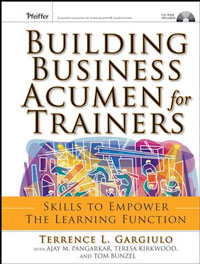(Originally published on ASTD Links March 4th, 2014 http://bit.ly/1gIJFJL)
After circulating the conference circuit in the past few months, we’ve been dismayed to see that many learning professionals believe learning’s role can, and possibly should, remain disconnected to from business reality. By no means do we want to minimize some of the worthy learning integration efforts many forward-thinking organizations initiate. But the fact remains that too many learning leaders and teams show disdain about recognizing workplace learning in a business context. Furthermore, they refuse to comply with their organization’s business reality. Instead, some professionals believe that learning is a noble effort, an attitude we find to be a bit arrogant. Often, these are the same people who are waiting for a quick fix that will gain their business leaders’ acceptance and make their learning efforts relevant.
The first step is to accept that internally, learning’s role is just another business activity like any other. Some people might find this statement to denigrate learning by equating it to business. But whether you’re organization is profit or not-for-profit, public or private, once leaders allocate or budget funds to an activity, it becomes a business activity—not a noble cause or charitable endeavor.
Every learning professional can make their life so much simpler by accepting this reality. First off, workplace learning would become business relevant. Recall for a moment a recent learning initiative accepted by your business leaders. Chances are they were convinced to provide funding because the activity fulfilled an immediate business need, not because of your charisma or charm. This win might have made you believe (falsely) that leaders would accept any of your learning activities. But if you don’t support the next initiative with a solid business case, your leaders will turn it down.
Leading learning organizations ensure that every learning initiative is relevant. For example, Wal-Mart is famous for the industry-leading supply chain management process. If you had a moment to speak with their learning leader, you would quickly discover that senior business leaders focus their resources and efforts to develop and maintain the various facets, skills, and knowledge around their supply chain process. This learning focus is business relevant.
Aligning to business needs
Accepting learning as a business activity leads to a second, and more meaningful, point, which is that learning must also align with business. Where business relevance applies to how learning efforts match an organization’s motivation and strategy, business alignment targets specific business areas and needs. Sounds simple enough but this is where most learning professionals fail. In our book, The Trainer’s Balanced Scorecard, we address both business relevance and alignment, but it is alignment that we find poses a challenge. We’ve seen learning professionals throw caution to the wind and believe that all they need to do is to develop a relevant learning solution and, once in place, employees and managers will figure how to align it to their specific business needs and objectives. If you really want to be taken seriously and build credibility with business leaders, then you’ll need to align with business demands. As we write in our book, this means you must become an operational partner rather than a functional department.
Being an operational partner means approaching business units to learn about their objectives instead of waiting for them to come to you. Discover which performance pressures preoccupy them. Identify their pain points and work closely to ascertain their specific learning requirements. Then be proactive and build a targeted learning strategy that will help meet their performance expectations.
An example of alignment is how Apple works to maintain their leading position for customer satisfaction with the publication Consumer Reports. More than simply training the AppleCare team to learn about product operation and features (Level 1 and 2), the company strives to ensure that its learning processes meet customer and product expectations (Level 3 and 4) and then focuses on the learning needs of the AppleCare group. The Apple learning department does this by aligning with a customer satisfaction business objective, conducting real-time skills assessments through employee testing, and working alongside the AppleCare group so employees are current on explicit performance expectations. This is learning that is business aligned.
Ultimately, your organization hired you for your learning expertise, and you are probably pretty good at it. It is incumbent upon us as learning professionals to prove that activities we propose are relevant to the organization and align with business needs.

Leave a comment